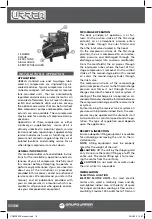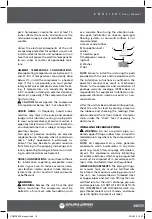
23
E N G L I S H •
User’s manual
to predict; therefore, URREA recommends that
you schedule a certified tank inspection within
the first five years of compressor service. To ar-
range a tank inspection, contact your closest
service center.
If the tank has not been inspected within the
first 10 years of compressor service, the re-
ceiver must be taken out of service until it has
passed inspection. Tanks that fail to meet re-
quirements must be replaced.
WARNING: Failure to replace a rusted air
receiver tank could result in air receiver tank
rupture or explosion, which could cause sub-
stantial property damage, severe personal
injury, or death. Never modify or repair tank.
Obtain replacement from service center.
TROUBLE SHOOTING:
AIR COMPRESSOR
ABNORMAL PISTON, RING OR CYLINDER
WEAR
Lubricant viscosity too low. Drain existing lu-
bricant and refill with proper lubricant.
Lubricant level too low. Add lubricant to
crankcase to proper level.
Detergent type lubricant being used. Drain ex-
isting lubricant and refill with proper lubricant.
Cylinder(s) or piston(s) scratched, worn or
scored. Repair or replace as required.
Extremely dusty atmosphere. Install remote air
inlet piping and route to source of cleaner air.
Install more effective filtration.
Extremely dusty atmosphere. Install remote air
inlet piping and route to source of cleaner air.
Install more effective filtration.
Worn cylinder finish. Deglaze cylinder with
180 grit flex-hone.
AIR DELIVERY DROPS OFF
Clogged or dirty inlet and/or discharge line fil-
ter. Clean or replace.
Lubricant viscosity too high. Drain existing lu-
bricant and refill with proper lubricant.
Compressor valves leaky, broken, carbonized
or loose. Inspect valves. Clean or replace as re-
quired. Install Valve/Gasket Step. Saver Kit.
Automatic drain valve clogged, leaking or de-
fective. Inspect valve and clean, repair or re-
place as required.
Piston rings damaged or worn (broken, rough
or scratched). Excessive end gap or side clear-
ance. Install Ring/Gasket Step Saver Kit.
Piston rings not seated, are stuck in grooves
or end gaps not staggered. Adjust piston rings.
Cylinder(s) or piston(s) scratched, worn or
scored. Repair or replace as required.
Defective safety/relief valve. Replace.
COMPRESSOR DOES NOT COME UP TO
SPEED
Loose beltwheel or motor pulley, excessive
end play in motor shaft or loose drive belts.
Check beltwheel, motor pulley, crankshaft,
drive belt tension and alignment. Repair or re-
place as required.
Lubricant viscosity too high. Drain existing lu-
bricant and refill with proper lubricant.
Improper line voltage. Check line voltage and
upgrade lines as required. Contact electrician.
Wiring or electric service panel too small. In-
stall properly sized wire or service box. Contact
electrician.
Poor contact on motor terminals or starter
connections. Ensure good contact on motor
terminals or starter connections.
Improper starter overload heaters. Install
proper starter overload heaters. Contact elec-
trician.
Compressor valves leaky, broken, carbonized
or loose. Inspect valves. Clean or replace as re-
quired. Install Valve/Gasket Step. Saver Kit.
Defective ball bearings on crankshaft or motor
shaft. Inspect bearings and replace if required.
Install Bearing/Connecting Rod. Step Saver Kit.
COMPRESSOR IS SLOW TO COME UP TO
SPEED
Leaking or maladjusted centrifugal pilot valve.
Replace pilot valve o-ring. Adjust pilot valve.
Leaking check valve or check valve seat blown
out. Replace check valve.
Pressure switch unloader leaks or does not
work. Realign stem or replace.
Ambient temperature too low. Install crank-
case heater kit. Relocate compressor to warmer
environment.
COMPRESSOR RUNS EXCESSIVELY HOT
Inadequate ventilation around beltwheel. Re-
locate compressor for better air flow.
COMP95XX manual.indd 23
23/06/15 14:27






































